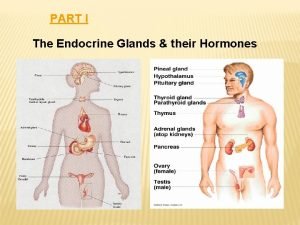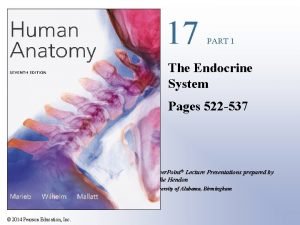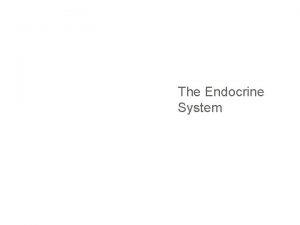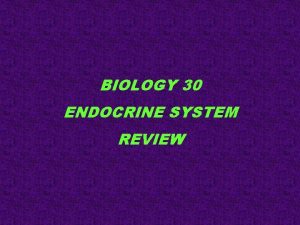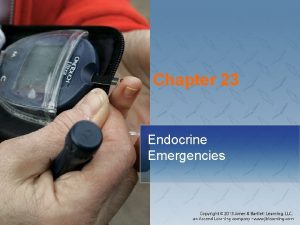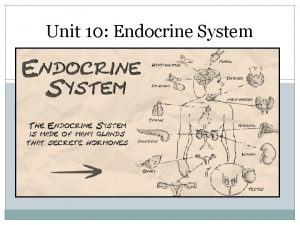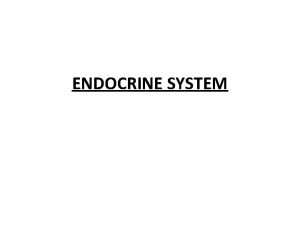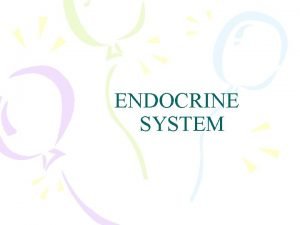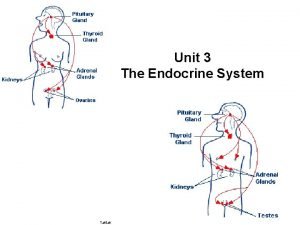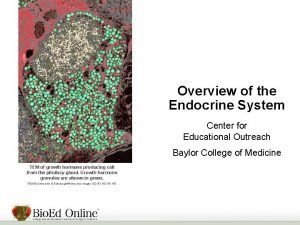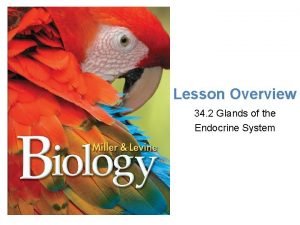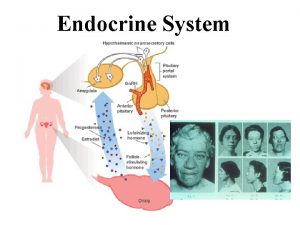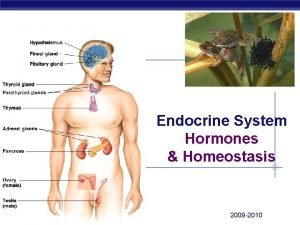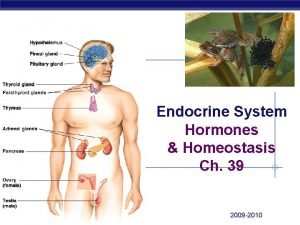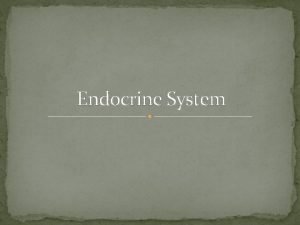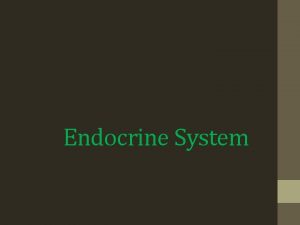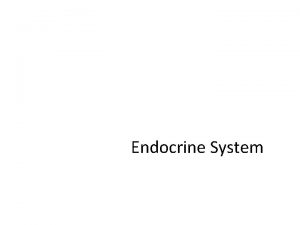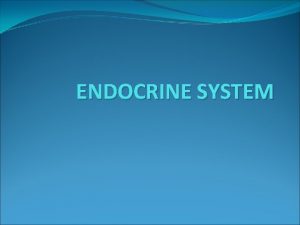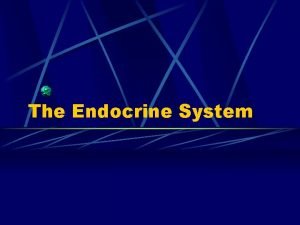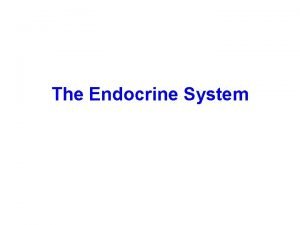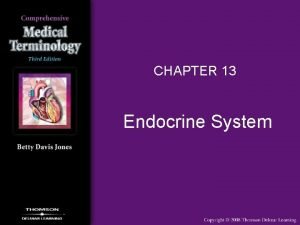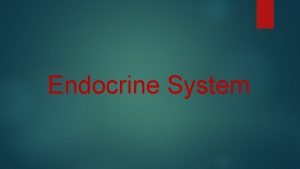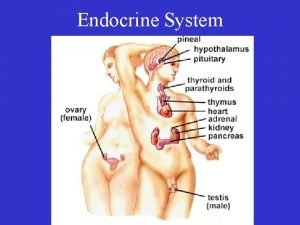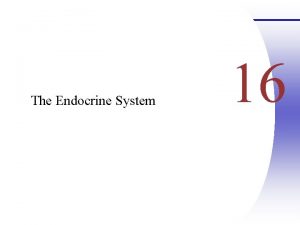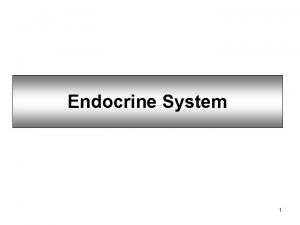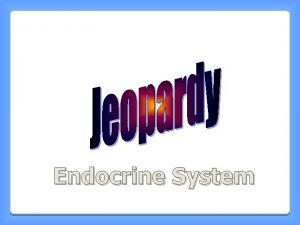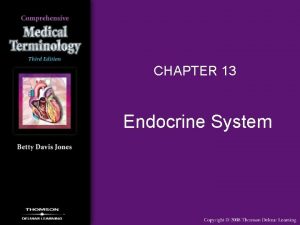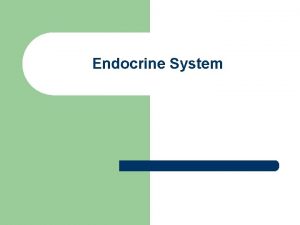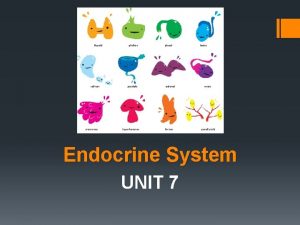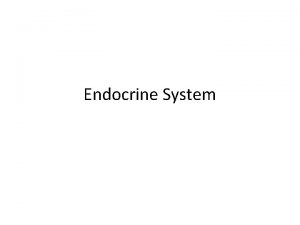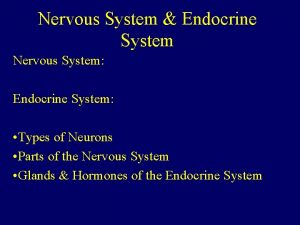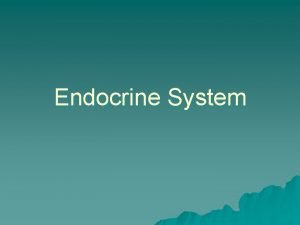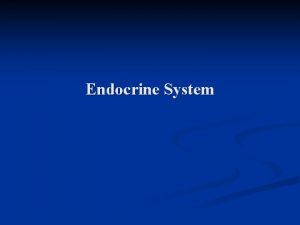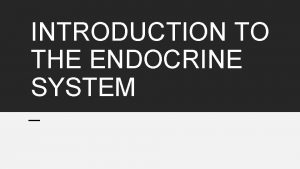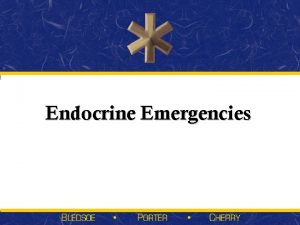The Endocrine System Foundation Standard 1 Academic Foundation



































- Slides: 35


The Endocrine System • Foundation Standard 1: Academic Foundation Understand human anatomy, physiology, common diseases and disorders, and medical math principles. 1. 13 Analyze basic structures and functions of human body systems • Endocrine versus exocrine • Structures of endocrine system • Functions of endocrine system • Hormones • Regulation of hormones 1. 21 Describe common diseases and disorders of each body system • Etiology • Pathology • Diagnosis • Treatment • Prevention 2

3

Endocrine vs Exocrine Endocrine • Ductless • Secretions empty into the blood • Secrete hormones • Have long term control of target organs Exocrine • May or may not have ducts • Secretions go directly to the target cells • Secrete enzymes • Have short term control 1. 13 Analyze basic structures and functions of human body systems endocrine). i. Endocrine (endocrine versus exocrine, functions of endocrine system) 4

The Endocrine System DUCTLESS GLANDS • Secrete chemical messengers (hormones) – Diffuse directly into the bloodstream – Interact with receptors inside/outside target cells – Involve growth, maturation, reproduction, metabolism, and human behavior 1. 13 Analyze basic structures and functions of human body systems endocrine). i. Endocrine (endocrine versus exocrine, structures and functions of endocrine system) 5

The Endocrine System Major Glands and Organs • • Hypothalamus Pituitary Thyroid Parathyroid • Pineal • Adrenal • Gonads – Testes – Ovaries • Pancreas • Thymus 1. 13 Analyze basic structures and functions of human body systems (endocrine). i. Endocrine (structures of endocrine system) 6

The Endocrine System Biofeedback mechanisms controls hormone levels Negative feedback (minimizes change) • If the hormone is high, the gland will stop producing it. • If the hormone is low, the gland will produce more. Positive feedback ( the change) • Stimulus is promoted until the hormone is no longer needed. – childbirth, labor stimulates the production of oxytocin until the baby is delivered. Oxytocin is no longer needed. 1. 13 Analyze basic structures and functions of human body systems endocrine). i. Endocrine (regulation of hormones) 7

Hypothalamus “Commander in Chief” • Link between endocrine and nervous system • Direct control of posterior pituitary gland – ADH and oxytocin • Indirect control through release of regulatory factors – Target-anterior pituitary gland Hormones ü CRH - Corticotropin- releasing hormone ü TRH - Thyrotropin-releasing hormone ü GH - Growth hormone o o GHIH - Growth hormone inhibiting hormone GHRH - Growth hormone releasing hormone ü PH - Prolactin-inhibiting hormone ü Gn. RH - Gonadotropin releasing hormones 1. 13 Analyze basic structures and functions of human body systems endocrine). i. Endocrine, structures and functions of endocrine system, hormones) 8

Hypothalamus CRH TRH GHIH/ GHRH Anterior Pituitary TSH GH ACTH PRL Hypothalamus Gn. RH Posterior Pituitary LH ADH Oxytocin FSH 1. 13 Analyze basic structures and functions of human body systems endocrine). i. Endocrine, structures and functions of endocrine system, hormones 9

Pituitary “Master Gland” • Secretes hormones that control other endocrine glands • Structurally divided into two parts: - Posterior pituitary gland - Anterior pituitary gland 1. 13 Analyze basic structures and functions of human body systems endocrine). i. Endocrine (structures and functions of endocrine system) 10

Pituitary Posterior Pituitary Gland • Oxytocin • ADH – Antidiuretic hormone (Vasopressin) Anterior Pituitary Gland • • • GH - Growth hormone (Somatotropin) TSH - Thyroid stimulating hormone (Thyrotropin) ACTH - Adrenocorticotropic hormone LH - Luteinizing hormone (female) FSH - Follicle stimulating hormone Prolactin - Lactogenic 1. 13 Analyze basic structures and functions of human body systems endocrine). i. Endocrine (hormones) 11

Posterior Pituitary ADH (antidiuretic hormone) = vasopressin • urination blood volume Water is reabsorbed in the tubules of the nephron • Large amounts of ADH urination blood pressure • Insufficient ADH diabetes insipidus Causing excessive urination fluids and electrolytes 1. 13 Analyze basic structures and functions of human body systems endocrine). i. Endocrine (functions of endocrine system, hormones, regulation of hormones) 1. 21 Describe common diseases and disorders of each body system a. Etiology b. Pathology c. Diagnosis d. Treatment e. Prevention 12

Posterior Pituitary Oxytocin - positive feedback- increase the magnitude of change – Stimulates the contraction of the smooth muscle of the uterus – Stimulates the mammary glands forcing milk into the ducts Indications for administration: – Given to induce labor – Given after delivery to constrict uterine blood vessels to minimize bleeding 1. 13 Analyze basic structures and functions of human body systems (endocrine). i. Endocrine (functions of endocrine system, hormones) 13

Anterior Pituitary Gland Growth Hormone (GH) Somatotropin Stimulates growth of body cells • Pituitary Dwarfism - Too little growth hormone (h. GH) - Proportions are normal • Gigantism - Excessive secretion of growth hormone (h. GH) • Acromegaly - Excess secretion of growth hormone (GH) after childhood 1. 21 Describe common diseases and disorders of each body system a. Etiology b. Pathology c. Diagnosis d. Treatment e. Prevention 14

Thyroid Gland • Located in front of the trachea • Secretes three hormones – T 3 Triiodothyronine ü Controls cell metabolism and growth ü Contains 3 iodine atoms – T 4 Thyroxine ü Controls cell metabolism and growth ü Contains 4 iodine atoms – Calcitonin ü Decreases blood calcium ü Stimulates bone development 1. 13 Analyze basic structures and functions of human body systems endocrine). i. Endocrine (functions of endocrine system, hormones) 15

Thyroid • Hypothyroidism – Hashimoto’s thyroiditis ü Most common cause ü Women 30 -50 years ü Autoimmune ü Low T 4 and high TSH ü Swelling of thyroid ü Treated with synthetic thyroid hormones ü May lead to goiters 1. 21 Describe common diseases and disorders of each body system a. Etiology b. Pathology c. Diagnosis d. Treatment e. Prevention 16

Thyroid • Hyposecretion of thyroid hormones during fetal development – Cretinism ü ü ü Skeleton fails to grow Usually severely mentally retarded Retarded sexual development Usually have a yellowish skin color Hormone therapy must begin before 2 months to alleviate symptoms 1. 21 Describe common diseases and disorders of each body system a. Etiology b. Pathology c. Diagnosis d. Treatment e. Prevention 17

Thyroid • Hypersecretion of thyroid hormone – Grave’s Disease ü Symptoms o o o o hot tremors sweating muscle weakness nervousness irritability bulging eyes 1. 21 Describe common diseases and disorders of each body system a. Etiology b. Pathology c. Diagnosis d. Treatment e. Prevention 18

Parathyroid Glands • Two small pairs of glands embedded in the posterior side of the thyroid • Produces PTH (Parathyroid Hormone) • Increases level of calcium in the blood: – stimulating bone-dissolving cells – kidneys to reabsorb calcium – intestines absorb calcium from food • Calcium is important: – bone growth – blood clotting – muscle tone and contraction (including the heart) 19

Parathyroid Glands Hyperparathyroidism • Hypercalcemia – leading to renal calculi – bone weakness • Often caused by a tumor (adenoma) • Treatment: surgical removal of the tumor Hypoparathyroidism • Hypocalcemia and elevated phosphorous – – can lead to tetany hyperirritability of the nervous system seizures death 1. 21 Describe common diseases and disorders of each body system a. Etiology b. Pathology c. Diagnosis d. Treatment e. Prevention 20

Adrenal Cortex Outer layer of the adrenal gland • Under the direction of the anterior pituitary [(Adrenocorticotropic Hormone (ACTH)] – Mineralocorticoids – Glucocortocoids – Gonadocorticoids 21

Adrenal Cortex Mineralocorticoids • Aldosterone Acts on the Kidneys: • Regulates sodium reabsorption • Regulates potassium excretion • Increases water reabsorption 22

Adrenal Cortex Glucocortocoids • Cortisol-hydrocortisone • Cortisone • Actions: – – metabolism increase blood glucose help resist stress anti-inflammatory to reduce immune responses 23

Adrenal Cortex Gonadocorticoids (sex hormones) • Estrogens – Stimulate the development of female sexual characteristics • Androgens – Stimulate the development of male sexual characteristics – Stimulate the female sex drive 24

Adrenal Medulla Epinephrine (Adrenaline) Norepinephrine • Actions: - Responsible for the “Fight or Flight” response - Helps the body cope with stress P heart rate P blood pressure P respirations - Sweaty palms - Dry mouth 25

Addison’s Disease Insufficient Adrenocorticosteriods • Cortisol • Aldosterone Causes: - autoimmune - infection - cancer Treatment: - hormone replacement Symptoms: • weight loss • muscle weakness • fatigue • low blood pressure • hypoglycemia • irritability • depression • skin pigmentation 1. 21 Describe common diseases and disorders of each body system – Endocrine System 26

Cushing’s Syndrome Over-secretion of Cortisol Causes: • Medical steroid use (Prednisone) • Pituitary (ACTH) or adrenal tumors • Genetic 1. 21 Describe common diseases and disorders of each body system a. Etiology b. Pathology c. Diagnosis d. Treatment e. Prevention 27

Cushing’s Syndrome Symptoms • • • upper body obesity round face bruising osteoporosis fatigue depression • • • hypertension high blood sugar female-facial hair male –decreased fertility retention of sodium – causes tissue fluid build up (puffiness) Treatment: • if tumor, remove • drugs to decrease cortisol level 1. 21 Describe common diseases and disorders of each body system a. Etiology b. Pathology c. Diagnosis d. Treatment e. Prevention 28

Pancreas A flat oblong organ located just posterior and slightly inferior to the stomach • Both an exocrine and endocrine gland – Exocrine tissue of the pancreas ü The bulk of the pancreas produces digestive enzymes ü Pancreatic duct connects to the duodenum – Endocrine tissue of the pancreas ü ü Islets of Langerhans release insulin and glucagon into the blood stream Regulate blood glucose levels 1. 13 Analyze basic structures and functions of human body systems (endocrine). i. Endocrine (endocrine versus exocrine, structures and functions of endocrine system, hormones) 29

Pancreas Types of Cells of the Islets of Langerhans • Alpha Cells - secrete glucagon – raises blood sugar • Beta Cells - secrete insulin – lowers blood sugar 30

Diabetes Mellitus • Disorder related to abnormal pancreatic hormones • Diabetes from Greek “siphon” and mellitus for honey • Symptoms include: – – Polyuria - excess urination Hyperglycemia glycosuria ü glucose in the urine Polydipsia - excessive thirst Polyphagia - excessive eating 1. 21 Describe common diseases and disorders of each body system a. Etiology b. Pathology c. Diagnosis d. Treatment e. Prevention 31

Type I Diabetes • Insulin Dependent Diabetes Mellitus (IDDM) - Pancreas does not produce insulin due to the destruction of beta cells in the Islets of Langerhans - Requires regular injections of insulin to prevent death - Most commonly develops in individuals younger than 20 years old ü (Juvenile Onset Diabetes Mellitus) - Appears to be an autoimmune disorder 1. 21 Describe common diseases and disorders of each body system a. Etiology b. Pathology c. Diagnosis d. Treatment e. Prevention 32

Type II Diabetes Non-Insulin Dependent Diabetes Mellitus (NIDDM) • Also called maturity onset diabetes • Most often occurs in individuals over 40 – being seen more in a younger age group • Affects the way the body processes glucose • Most individuals are overweight or clinically obese Treatment: • • Medications Diet Exercise Weight loss and control 1. 21 Describe common diseases and disorders of each body system a. Etiology b. Pathology c. Diagnosis d. Treatment e. Prevention 33

Complications from Diabetes • • • Atherosclerosis Heart disease Peripheral vascular disease Severe kidney damage Glaucoma and/or blindness Gangrene Ketoacidosis Weight loss Neuropathy 1. 21 Describe common diseases and disorders of each body system a. Etiology b. Pathology c. Diagnosis d. Treatment e. Prevention 34

Other Glands Thymus Gland • Functions in the endocrine and lymphatic systems – – Produces a hormone called thymosin Hormone that supports function of WBCs • Begins to atrophy at puberty Pineal Gland • Produces melatonin • Regulates sleep patterns 35
 Composition of urine slideshare
Composition of urine slideshare Endocrine system and reproductive system
Endocrine system and reproductive system Endocrine system and nervous system
Endocrine system and nervous system Lymphatic system vs endocrine system
Lymphatic system vs endocrine system Nervous system vs endocrine system venn diagram
Nervous system vs endocrine system venn diagram Adh function
Adh function Endocrine
Endocrine Adenohypophysis
Adenohypophysis Sympathetic nervous system
Sympathetic nervous system Comparison of endocrine and nervous system
Comparison of endocrine and nervous system Steroids endocrine system
Steroids endocrine system Endocrine system fact
Endocrine system fact Rhinarium
Rhinarium Chapter 45 hormones and the endocrine system
Chapter 45 hormones and the endocrine system Metabolic action of growth hormone
Metabolic action of growth hormone Exocrine glands are ductless
Exocrine glands are ductless Chapter 7:13 endocrine system
Chapter 7:13 endocrine system Stimulus endocrine system
Stimulus endocrine system Stimulus humoral
Stimulus humoral Hypothal
Hypothal Biology 30 endocrine system
Biology 30 endocrine system Site:slidetodoc.com
Site:slidetodoc.com Chapter 23 the endocrine system
Chapter 23 the endocrine system Endocrine system analogy
Endocrine system analogy Introduction of endocrine system
Introduction of endocrine system Endocrine system abbreviations
Endocrine system abbreviations Endocrine system
Endocrine system Endocrine system
Endocrine system Endocrine system
Endocrine system Baylor
Baylor Endocrine glands
Endocrine glands Endocrine system
Endocrine system Chapter 16 lesson 3 the female reproductive system
Chapter 16 lesson 3 the female reproductive system Endocrine system regents questions
Endocrine system regents questions Endocrine system regents questions
Endocrine system regents questions Hormones
Hormones







